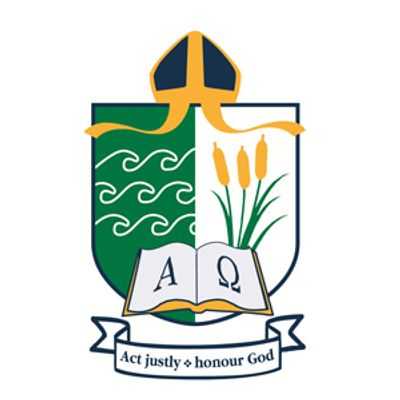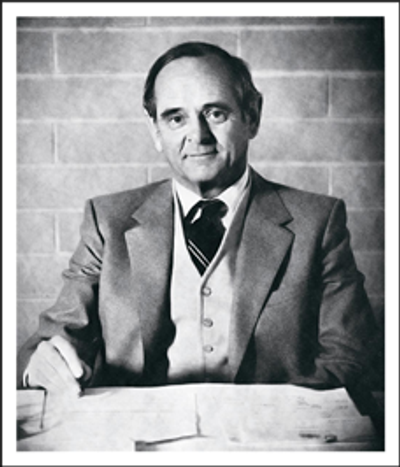School Crest

The Story of the Crest
The Bishop’s Mitre shows the connection between the School and the Anglican Church. The Bishop has authority over the School, so the Bishop’s Mitre sits at the top.
The Shield contains several important symbols. The waves of the left panel indicate the geographic position of the School near the ocean. They also represent one of the meanings of the word ‘mindarie’, which is ‘place of green water’.
The right panel contains three rushes/grass tree stems. This symbol has several meanings. It represents another meaning of the word ‘mindarie’, which is ‘dry leaves from a grass tree’. It also creates a link to the family name of Peter Moyes. ‘Moyes’ is Old French for the Hebrew word ‘Moses’. Moses as a young boy was hidden from the Egyptian Pharaoh’s men in the bulrushes by the edge of the river Nile.
The open book represents the Bible, the text that contains the teachings and truths upon which our Christian faith and Anglican tradition are founded. In Revelation 1:8, God identified himself as the "Alpha and Omega," the one “who is, and who was, and who is to come, the Almighty.” The Alpha and Omega are the first and last letters of the Greek alphabet. These were therefore used as early Christian symbols signifying that God is "the beginning and the end," meaning that God is eternal and that we look forward to His return.
The motto, ‘Act justly, honour God’ directly refers to two important parts of life. The first phrase, ‘Act justly’, sets a high ideal for all to aspire to in life, treating all as we would like to be treated. ‘Honour God’, the second phrase, indicates the spiritual aspect of life that is important in order to lead a full and rich existence. To ‘Act justly’ and to ‘honour God’ require us to acquire the skills and knowledge necessary to be able to act in this manner. Learning to acquire the attitudes, skills and knowledge to be able to ‘Act justly, honour God’ is our aim.
School Patron

Peter Morton Moyes (9 July 1917 - 27 July 2007) was the fourth of six children born to John and Helen Moyes. He was educated at St Peter’s College in South Australia and The Armidale School in New South Wales. In 1939, he graduated with an Arts Degree from Sydney University.
His teaching appointments included:
Canberra Grammar School (Assistant Master) King’s School, Bruton, UK Winchester College, UK (Latin and History Teacher) Geelong Grammar School (Senior History Master) Christ Church Grammar School (Head Master from 1951 to 1981). During the Second World War, Mr Moyes served with the Australian Army in Syria and Egypt and in New Guinea on the Kokoda Track. He attained the rank of Captain.
Mr Moyes served the wider educational community through Chairmanship of the Headmasters’ Conference in 1973-75 and was three times President of the Association of Independent Schools of WA.
In 1982, after retiring from Christ Church Grammar School, Mr Moyes joined the Catholic Education Commission to develop programmes for handicapped and disadvantaged youth, a position he held in a part-time capacity until 1985. It was also at this time that Mr Moyes began to devote himself to the establishment of the Anglican Schools’ Commission (now AngliSchools). He was the Foundation Chairman in 1985 and his vision of co-educational, low-fee Anglican schools came to fruition in 1986 with the establishment of St Mark’s Anglican Community School.
In his time as Chairman, from 1985 until 1993, the Commission successfully established five low-fee Anglican schools. In 1999, Peter Moyes Anglican Community School in Mindarie, a northern beachside suburb of Perth, was named in his honour, becoming the fifth school established by the Anglican Schools Commission. Mr Moyes took an active interest in the development of the school until his death, regularly meeting over afternoon tea with Mr Allan Shaw, the Foundation Principal.
In recognition of his service to the community, Mr Moyes was made an Officer of the Order of the British Empire (OBE) in 1982, a Member of the Order of Australia (AM) in 1995 and Western Australian Citizen of the Year for the Professions in 1991. His professional awards include a Fellowship of the Australian College of Education (FACE) in 1969 and Life Membership of the Anglican Schools Commission in 1994.
In honour of Mr Moyes, Peter Moyes Day is celebrated annually at the School.
House Patrons
Our House system supports students and staff by adding to the vibrancy of School life. By creating a community within a community, the system provides an opportunity for students of all ages to develop friendships with other students and staff. Such connections with their peers enable students to develop self-esteem, confidence and maturity.
All students and staff are placed in one of the six Houses - Cowan, Cuthbert, Durack, Florey, Hollows or Lingiari.
Below is a summary of our House Patrons:
Cowan House

Cowan House is named after Edith Cowan (1861 - 1932). Edith Cowan embodies the School Values through her remarkable contributions to Australian society, particularly in the fields of education and women's rights. Her pioneering efforts as the first woman elected to an Australian parliament and her tireless advocacy for social justice have left an indelible mark on our nation. Additionally, Edith Cowan was the first woman elected to the Anglican Synod in 1916.
Cuthbert House

Cuthbert House is named after Betty Cuthbert (1938 - 2017) who, as an Olympic athlete and winner of 4 Gold medals, showed the values of courage, determination and ambition. Betty was diagnosed with Multiple Sclerosis and then dedicated her life to helping educate others about Multiple Sclerosis and promoting research into it. She has used her faith in God to assist her in dealing with her disease.
Durack House

Durack House is named after Mary Durack (1913 – 1994) who saw her fair share of hardships, whilst young, which encouraged her to survive and develop a positive attitude to life. Her positive attitudes towards learning, equality and kinship have influenced society. Durack believed in knowledge and insight as shown through her thorough research of topics presented in her novels. She also strongly believed in equality and compassion for all, as she was dedicated to gaining aboriginal rights, and her success in literature was through personal confidence and competence.
Florey House

Florey House is named after Baron Howard Florey of Adelaide OM FRS FRCP (1898 – 1968) who was an Australian pharmacologist and pathologist. During his remarkable career in science, he shared the Nobel Prize in Physiology or Medicine in 1945 with Sir Ernst Boris Chain and Sir Alexander Fleming for his role in the development and mass production of penicillin. Florey’s portrait appeared on the Australian $50 note between the years 1973-1995.
Hollows House

Hollows House is named after Professor Fred Hollows (1929-1993). As an eye surgeon, he helped those living in poverty prevent and overcome blindness. He accomplished this through his passion to help others. He created the Fred Hollows Foundation which has continued his work after his death. It helps others that cannot afford surgery by running as a non-profit organisation and can be found in many places throughout the world. His achievements have allowed many people to see again and created hope for those less fortunate than ourselves.
Lingiari House

Lingiari House is named in honour of Vincent Lingiari OAM (1908-1988) who was a member of the Gurindji people from the Victoria River District, Northern Territory. He worked for many years to improve conditions for Aboriginal people working on cattle stations. He led a strike of indigenous stockmen that would eventually reshape the agenda of relationships between indigenous Australians and the wider community.
School Prayer
Almighty God,
We ask for Your protection over our School.
Bless all who come here to work, to learn and to serve.
Grant us to grow in faith, hope, love and wisdom.
Keep us ever mindful of the needs of others,
And we pray all our works will bring glory
And honour to Your name.
We ask this through Jesus Christ, Your Son, our Lord.
Amen.